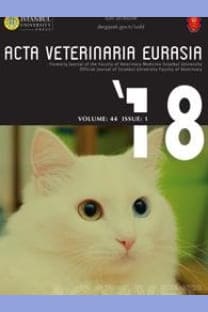Presence of the Parafollicular Cells in the Thyroid Gland of the One-Humped Camel
The thyroid is an important endocrine gland that affects many organs of the body. A limited number of works have been done on the morphological and histological characteristics of this gland in the camel and controversial debates have been made on the presence of parafollicular cells. The aim of this study is to investigate the histological structure of the thyroid in the camel and determine the presence of parafollicular cells in this gland. This study was performed on 20 camels. The histological structure of the thyroid was studied using light microscope after preparing sections and staining it with Hematoxylin & Eosin, Verhoeff, and Toluidine blue. Thyroid gland has follicles of different sizes, follicular and parafollicular cells, and according to our results these cells are forming about 59.1% and 5% of the gland volume respectively. The large follicles are located in the peripheral part of the gland while the small follicles are seen in the central part of the gland. The central parts of the gland have a more extensive vascular bed than the peripheral parts. This study revealed that the thyroid gland in camel has parafollicular cells, but most of them are present in the central part of the gland.
___
Abdel-Magied, E.M., Taha, A.A., Abdalla, A.B., 2000. Light and electron microscopic study of the thyroid gland of the camel (Camelus dromedarius). Anatomia Histologia Embryologia 29, 331- 336. [CrossRef]Allen, A.l., Fretz, P.B., Card, C.E., Doige, C.E., 1998. The effects of partial thyroidectomy on the development of the equine fetus. Equine Veterinary Journal 30, 53-59. [CrossRef]
Atoji, Y., Yamamoto, Y., Suzuki, Y., Sayed, R., 1999. Ultrastructure of the thyroid gland of the one-humped camel (Camelus dromedarius). Anatomia Histologia Embryologia 28, 23-26. [CrossRef]
Bancroft, J.D., Gamble, M., 2008. Theory and Practice of Histological Techniques. 6th ed. Philadelphia, Churchill Livingstone, pp. 295-307.
Banks, W.J., 1993. Applied Veterinary Histology. Philadelphia, Mosby, pp. 414-424.
Culling, C.F., Allison, T.R., 1985. Cellular Pathology Technique. 4th ed. London, Butterworths, pp. 113- 479. [CrossRef]
Dyce, K.M., Sack, W.O., Wensing, C.J.G., 1996. Textbook of Veterinary Anatomy. Philadelphia, W.B. Saunders Company, pp. 211-649.
Fujita, H., 1975. Fine structure of the thyroid gland. International Review of Cytology. 40, 197-274. [CrossRef]
Glauert, A.M., Lewis, P.R., 1998. Biological Specimen Preparation for Transmission Electron Microscopy. Vol. 17, Portland press, London. [CrossRef]
Hillson, S., 2005. Teeth. Cambridge University Press, New York, pp. 223-245. [CrossRef]
Hyttel, P., Sinowatz F., Vejlested, M., 2010. Essentials of Domestic Animal Embryology. Philadelphia, W.B. Saunders Elsevier, pp. 230.
Kausar, R., Shahid, R.U., 2006. Gross and microscopic anatomy of thyroid gland of one humped camel (Camelus Dromedarius). Pakistan Veterinary Journal 26, 88-90.
Kurihara, H., Uchida, K., Fujita, H., 1990. Distribution of microtubules and microfilaments in the thyroid follicular cells of normal TSH-treated and hypophysectomized rats. The Histochemical Journal 93, 335- 345. [CrossRef]
Manohar, M., Goetz, T.E., Saupe, B., Hutchens, E., Coney, E., 1995. Thyroid, renal and splanchnic circulation in horses at rest and during shortterm exercise. American Journal of Veterinary Research 56, 1356-1361.
Mason, R., Wilkinson, J.S., 1973. The thyroid gland. A review. Australian Veterinary Journal 49, 44-49. [CrossRef]
Mubarak, W., Sayed, R., 2005. Ultramicroscopical study on thyrocalcitonin cells in the camel (camelus dromdarius). Anatomia Histologia Embryologia 34, 35. [CrossRef]
Nickel, R., Schummer, A., Seiferle, E., 1979. The Viscera of the Domestic Mammals. Berlin, Verlag Paul Parey, pp. 64-235. [CrossRef]
Pousty, I., Adibmorady, M., 2003. Comparative Histology and Histotechnique. University of Tehran Press, Tehran, pp. 253-254.
Sisson, S., Grossman, J.D., Getty, R., 1975. The Anatomy of the Domestic Animals, Volume 1, Philadelphia, W.B. Saunders Company, pp. 150-154.
Solcia, E., Capella, C., Vassallo, G., 1969. Lead-Haematoxylin as a Stain for Endocrine Cells, Significance of Staining and Comparison with other Selective Methods. Histochemistry and Cell Biology 20, 116-126. [CrossRef]
SPSS Inc. Released 2003. Released 2003. SPSS for Windows, Version 12.0. Chicago, SPSS Inc.
Sridharan, G., Shankar, A.A., 2012. Toluidine blue: A review of its chemistry and clinical utility. Journal of Oral and Maxillofacial Pathology 16, 251-255. [CrossRef]
Weibel, E.R., 1979. Stereological methods. Practical methods for biological morphometry. Vol. 1. Academic Press, London, pp. 101-108.
Yagil, R., Etzion, Z., Ganani, J., 1978. Camel thyroid metabolism: Effect of season and dehydration. Journal of Applied Physiology 45, 540-544. [CrossRef]
- ISSN: 2618-639X
- Başlangıç: 1975
- Yayıncı: İstanbul Üniversitesi-Cerrahpaşa
Sayıdaki Diğer Makaleler
Presence of the Parafollicular Cells in the Thyroid Gland of the One-Humped Camel
EYÜP EREN GÜLTEPE, Aamir IQBAL, İBRAHİM SADİ ÇETİNGÜL, Cangir UYARLAR, Ümit ÖZÇINAR, İSMAİL BAYRAM
Maintenance of Thermal Homeostasis with Special Emphasis on Testicular Thermoregulation
Adeel SARFRAZ, Anas Sarwar QURESHI, Rehmat Ullah SHAHID, Mumtaz HUSSAIN, Muhammad USMAN, Zaima UMAR
